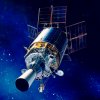| . |  |
. |
|
By Nicole VanNatter  Peterson (AFPN) November 12, 1999 - Air Force satellites are expected to sail through the potentially worst meteor shower in 33 years; however, Air Force Space Command people are not leaving anything to chance.
Peterson (AFPN) November 12, 1999 - Air Force satellites are expected to sail through the potentially worst meteor shower in 33 years; however, Air Force Space Command people are not leaving anything to chance.AFSPC and other national agencies have been diligently working on a host of plans and operations that will ensure critical communication, navigation and surveillance systems stay operational. This year marks what is likely to be the last in the 33-year cycle of the comet Tempel-Tuttle that produces what is commonly known as the Leonid meteor shower. The height of the Leonid meteor shower will be the evening of Nov. 17 in most of North America. Tempel-Tuttle has been orbiting the sun opposite the Earth for nearly 2,500 years, but only poses a potential threat to the Earth three years out of each 33-year cycle said Lt. Col. Don Jewell, AFSPC's deputy chief scientist. The comet travels 43 to 45 miles per second, relative to Earth's orbit, leaving a huge trail of dust through which the earth travels when their paths cross. The Temple-Tuttle is one of the fastest comets known to man. The increased speed makes the comet's particles more dangerous to space satellites. The debris trail of the comet contains particles from 0.04 to 0.40 of an inch in size. Radiation hardening gives military satellites greater protection than civilian satellites from the flying debris. Although the comet does contain particles up to 0.40 of an inch in size, the chances of one of those hitting a satellite are very small, said Jewell. "If one of those hit a satellite, it would be like a bullet hitting a satellite and certainly it would damage it," said Jewell. "We don't anticipate that happening, but we have to plan for it." And planning is exactly what's been going on since last year's Leonid storm. "This year we are focusing on refining the Leonid plan that was developed last year," said Lt. Col. Doug Hine, 14th Air Force's chief, space operations branch. "We took lessons learned and ensured satellite and ground systems are prepared to weather the storm." The Leonid storm of 1966 was the last time the meteor shower impacted the nations' space assets. The potential harm was minimal though because America only had 50 or 60 satellites in orbit then, said Jewell. The real concern came 32 years later, in 1998, when the United States had several hundred military satellites in orbit, operating everything from early missile warning to the Global Positioning System. "Essentially, it was a non-event," said Jewell. Three civilian satellites were damaged, but all military space assets were left unharmed. There is not expected to be any damage to military satellites this year either, said Jewell, but the Air Force is prepared for the worst. The Air Force began planning for the 1998 Leonid storm a full year in advance. Hundreds of thousands of dollars were allocated for Leonid preparation, but the money ran out and the analysis of the data could not be completed, said Hine. This year, the Air Force and other sister agencies are poised to spend $2 million to proactively protect U.S. space assets, said Hine. Special electro-optical video equipment will be set up at sites in Hawaii, Florida, the Canary Islands, Kwajalein Atoll in the Marshall Islands and at two sites in the Negev Desert, Israel, to record the storm as it develops. The video signals go to the Marshall Space Flight Center in Huntsville, Ala. The center will give real-time storm warnings when necessary. The Air Force will also monitor the storm 24-hours a day Nov. 16 through 18 through mobile multi-frequency high-frequency radar deployed in Canada. Additionally, aircraft are being deployed Nov. 16 to perform high-altitude observation and collect data on the Leonid storm. "We don't want to downplay this. We plan for the worst and hope for the best," said Hine. "Air Force Space Command has experienced and well-trained crews who are prepared and ready to respond to any problems that may surface during the storm." The good news is, when Nov. 17th is over, so are the short-term Leonid worries. "We won't have any problems with it again for about another 30 years," said Jewell. So what's the advice for people Nov. 17? Sit back and enjoy because "it ought to be a beautiful show," said Jewell.
SPACE SCIENCE
Additional Leonids Sites of Note
|
| |||||||||
| The content herein, unless otherwise known to be public domain, are Copyright 1995-2016 - Space Media Network. All websites are published in Australia and are solely subject to Australian law and governed by Fair Use principals for news reporting and research purposes. AFP, UPI and IANS news wire stories are copyright Agence France-Presse, United Press International and Indo-Asia News Service. ESA news reports are copyright European Space Agency. All NASA sourced material is public domain. Additional copyrights may apply in whole or part to other bona fide parties. Advertising does not imply endorsement, agreement or approval of any opinions, statements or information provided by Space Media Network on any Web page published or hosted by Space Media Network. Privacy Statement All images and articles appearing on Space Media Network have been edited or digitally altered in some way. Any requests to remove copyright material will be acted upon in a timely and appropriate manner. Any attempt to extort money from Space Media Network will be ignored and reported to Australian Law Enforcement Agencies as a potential case of financial fraud involving the use of a telephonic carriage device or postal service. |